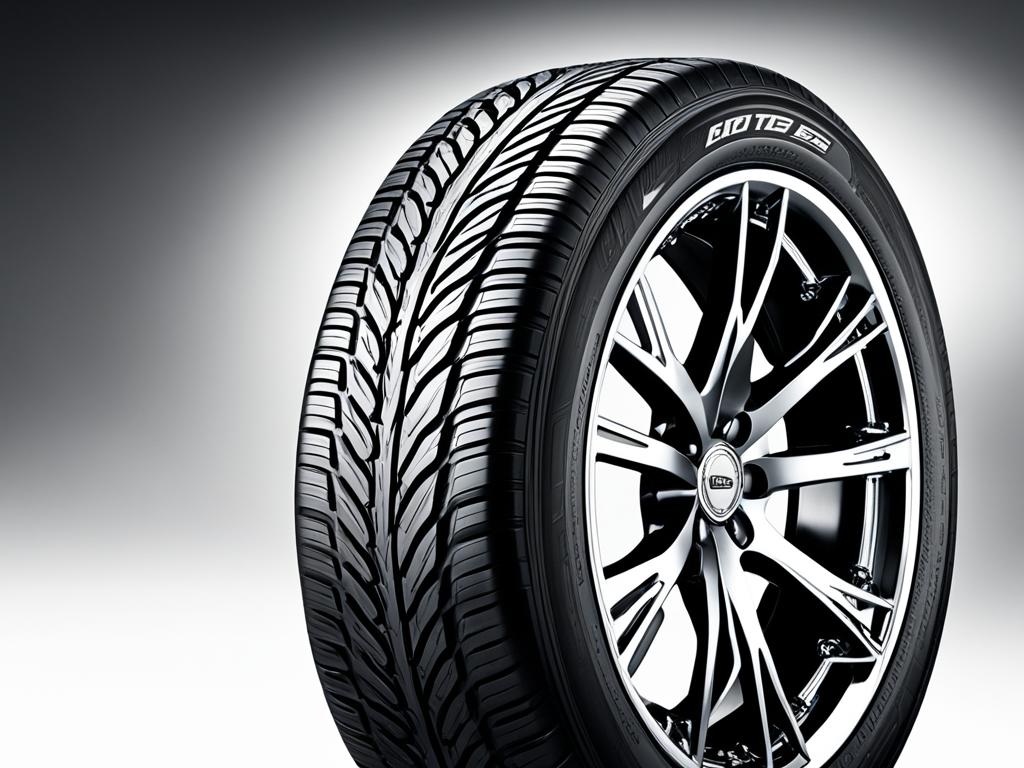Have you ever wondered how old your tires are? Do you know how to determine the manufacturing date of your tires? Knowing the age of your tires is crucial for ensuring your safety on the road and optimizing the performance of your vehicle. In this comprehensive guide, we will walk you through a step-by-step process on how to check the tire manufacturing date.
By understanding the tire identification numbers, locating the manufacturing date on your vehicle, and decoding the DOT code, you can accurately determine the age of your tires. We will also discuss the significance of the tire production date, safety concerns with older tires, and when it’s time to consider replacing them.
Are you ready to uncover the secrets of tire manufacturing dates and ensure the longevity of your tires? Let’s get started!
Key Takeaways:
- Checking the manufacturing date is essential for tire age verification and safety.
- Tire manufacturing dates can be found by decoding the DOT code.
- Inspecting tires for age-related wear and tear is crucial for identifying potential issues.
- Understanding the significance of tire production dates helps in making informed decisions about tire maintenance and replacement.
- Regular tire inspections and proper maintenance are key to maintaining tire health beyond the manufacturing date.
Understanding Tire Identification Numbers
Table of Contents
ToggleTire identification numbers, commonly known as DOT codes, play a crucial role in determining the manufacturing date of your tires. By understanding how to read the DOT code, you can accurately determine the manufacturing date of your tires and ensure their safety and performance.
Discovering Your Tire's DOT Code
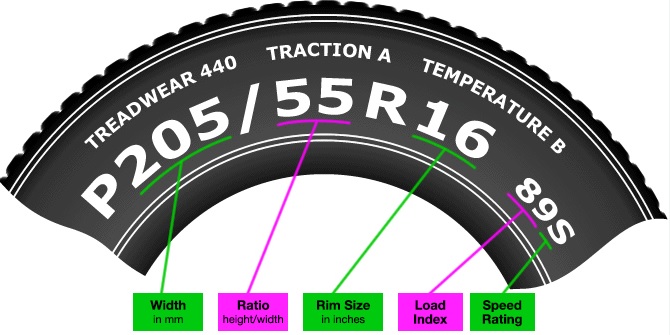
The DOT code is usually located on the sidewall of the tire. Look for a series of characters that start with the letters “DOT” followed by a combination of numbers and letters. It is important to note that the DOT code is embossed on one side of the tire, so make sure you check both sides when locating the code.
To help you visualize the location of the DOT code on your tire, refer to the image below:

Deciphering the DOT Number Sequence
The DOT number sequence is composed of several components that provide important information about your tire. These components include the plant code, manufacturer tire size, brand-specific characteristics, and the date of manufacturing.
Here’s a breakdown of the different components of the DOT code:
- Plant Code: The plant code identifies the tire manufacturing facility.
- Manufacturer Tire Size: This portion of the DOT code indicates the size of the tire.
- Brand-Specific Characteristics: Some DOT codes may include brand-specific characteristics or additional information about the tire.
- Date of Manufacturing: The last four digits of the DOT code represent the week and year of tire manufacturing. The first two digits indicate the week, while the last two digits indicate the year.
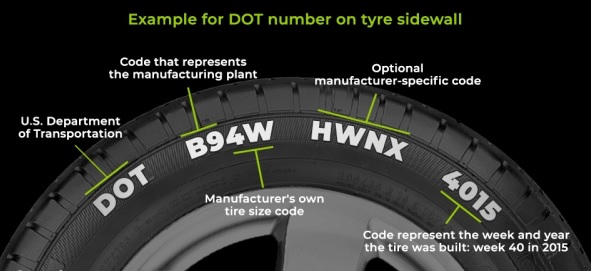
By decoding the DOT number sequence, you can determine the manufacturing date of your tire and ensure that it is within a safe age range.
Learn more about How to resolve tire noise after rotation
Locating the Tire Manufacturing Date on Your Vehicle
Finding the tire manufacturing date on your vehicle is essential for identifying the age of your tires. By knowing where to find the manufacturing date, you can easily check the age of your tires and make informed decisions about maintenance and replacement.
There are several locations where you can locate the tire manufacturing date:
- On the sidewall of the tire: Look for a series of numbers located on the sidewall of the tire. The manufacturing date is usually represented by the last four digits within this series. It is often enclosed by an oval or a rectangular box.
- On the driver’s side door jamb sticker: Open the driver’s side door and locate the sticker attached to the door jamb. Look for a section that displays information about the tires, including the manufacturing date.
- In the owner’s manual: Consult your vehicle’s owner’s manual for information about the tire manufacturing date. The manual may provide specific instructions on how to locate the date.
Be sure to check all four tires on your vehicle, as each tire may have a different manufacturing date. This is especially important if you have replaced any of the tires at different times.
Once you have located the manufacturing date, you can refer to the next section to learn how to check and decipher the tire manufacturing date codes.
Learn more about How to react if you experience tire blowout while driving
How to Check Tire Manufacturing Date
Reading the Last Four Digits for Manufacture Date
To check the manufacturing date of your tires, you need to focus on reading the last four digits of the DOT code. These four digits represent the week and year of production.
Here’s how to decode the last four digits:
- Locate the DOT code on the sidewall of your tire. It’s a combination of letters and numbers.
- The last four digits indicate the week and year of manufacture.
- The first two digits represent the week of production, ranging from 01 to 52.
- The last two digits represent the year of production, such as 20 for 2020.
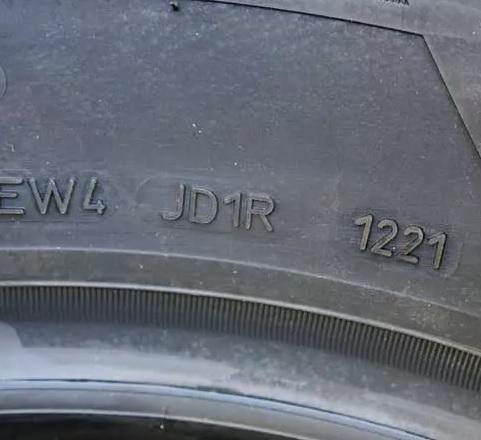
For example, if the last four digits of the DOT code are 2518, it means the tire was manufactured in the 25th week of 2018.
Interpreting Tires Made Before the Year 2000
Tires manufactured before the year 2000 have a different coding system. Instead of the current 4-digit format, the last three digits represent the week and year of manufacture. Here’s how to interpret tires made before the year 2000:
- Locate the DOT code on the sidewall of your tire.
- The last three digits indicate the week and year of manufacture.
- The first two digits represent the week of production, ranging from 01 to 52.
- The last digit represents the year of production.
For example, if the last three digits of the DOT code are 368, it means the tire was manufactured in the 36th week of the 8th year of a decade. To determine the exact year, refer to the tire’s age based on its date of manufacture.
Learn more about Tire tread depth chart
Significance of the Tire Production Date
Understanding the significance of the tire production date is crucial for maintaining the safety and performance of your vehicle. Your tire’s birth date, also known as the manufacturing date, provides valuable information about its age and condition. By knowing when your tire was manufactured, you can make informed decisions regarding its maintenance and replacement.
An important reason why knowing your tire’s birth date matters is because tire performance can be greatly affected by age. As tires age, the rubber compound can deteriorate, leading to reduced grip on the road. This can result in compromised handling and braking capabilities, especially in wet or slippery conditions. Older tires are also more prone to tread separation, which can cause sudden blowouts and loss of control while driving.

Older tires may have safety concerns that can put you and your passengers at risk. Over time, the structural integrity of the tire may be compromised, increasing the likelihood of tire failure. This can lead to dangerous accidents and potentially life-threatening situations. By paying attention to the manufacturing date of your tires, you can identify if they have reached the end of their recommended lifespan and take appropriate action to ensure your safety on the road.
Ultimately, understanding the significance of the tire production date empowers you to prioritize your safety and make informed decisions about tire maintenance and replacement. By keeping track of your tire’s age and condition, you can ensure that you are driving with the highest levels of safety and performance.
Inspecting Tires for Age-Related Wear and Tear
Regular inspection of your tires is essential for detecting age-related wear and tear. By conducting regular inspections, you can identify potential issues and take appropriate measures to ensure the safety and longevity of your tires.

When inspecting your tires, pay attention to the following common indicators of aging:
- Cracks: Check the sidewalls of your tires for any visible cracks. Cracks can indicate that the rubber is becoming brittle and may lead to tire failure.

- Bulges: Look for any bulges or bubbles on the sidewalls of your tires. Bulges can suggest internal damage or weakened areas, increasing the risk of a blowout.
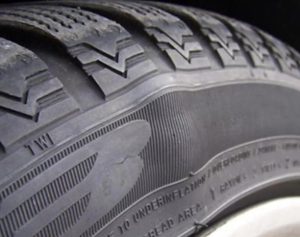
- Tread Wear: Examine the tread depth and pattern on your tires. Excessive wear or uneven tread patterns can affect your tire’s grip and traction, compromising your safety on the road.
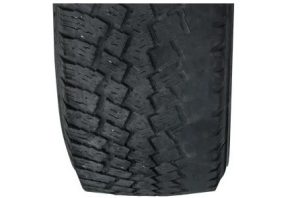
Inspecting your tires regularly allows you to catch these signs of aging early on, enabling you to take the necessary steps to address any issues. If you notice any of these indicators or have concerns about the condition of your tires, it’s best to consult a professional tire service provider for further evaluation.
Remember, proper tire maintenance plays a crucial role in ensuring your safety on the road. Regular inspections, tire rotations, and maintaining proper tire pressure are important steps in preventing accidents and maximizing the lifespan of your tires.
Learn more about Best off road tire for Tacoma
The Life Span of Your Tires and When to Consider Replacement
Understanding the life span of your tires and knowing when to consider replacement is crucial for maintaining optimal performance and safety. Over time, tires can deteriorate due to various factors, including wear and tear, exposure to extreme temperatures, and aging. It is important to be proactive in assessing the condition of your tires to ensure they are safe for the road.
Understanding Tire Age Limits
Tire age limits refer to the recommended lifespan of tires, beyond which their performance and safety may be compromised. While the specific age limit can vary depending on factors such as tire type, usage, and storage conditions, most experts recommend replacing tires that are more than six years old, regardless of their apparent tread depth or condition.
There are several reasons why tire age is a significant factor in replacement considerations. Over time, the rubber compounds in tires can deteriorate, leading to reduced traction, increased risk of blowouts, and decreased overall performance. Additionally, older tires are more prone to sidewall cracking and tread separation, which can compromise their structural integrity and pose serious safety hazards on the road.

It’s important to note that even if your tires appear to have sufficient tread depth and show no visible signs of wear, they may still require replacement due to aging. Regular inspections and assessments of tire age are essential to ensure safe driving conditions.
Assessing Spare Tires for Age and Safety
While spare tires may not be frequently used, it is crucial to assess their age and overall condition to ensure they are safe to rely on in case of emergencies. Spare tires are typically designed for temporary use and may have different age limits compared to regular tires.
When assessing the age of a spare tire, you can locate the manufacturing date using the same methods discussed earlier in this article. It is important to note that spare tires, especially those stored in vehicles for an extended period, may also experience degradation due to factors such as exposure to sunlight and fluctuations in temperature.
Inspect the spare tire for any signs of dry rot, such as cracks or deformities, as these can indicate age-related deterioration. Additionally, ensure that the spare tire is properly inflated and that the tread depth meets the minimum requirements for safe use.
Considering the vital role of spare tires in emergency situations, it is recommended to replace them if they are more than ten years old or if there are any signs of age-related wear and tear. Regularly checking the age and condition of your spare tire will help ensure your safety on the road.
Conclusion
In conclusion, understanding the manufacturing date of your tires is vital for maintaining their health and ensuring your safety on the road. By following the steps outlined in this guide, you can easily check and interpret the tire date code to determine the age of your tires accurately.
However, tire maintenance goes beyond just checking the manufacturing date. To keep your tires in optimal condition, you need to prioritize regular inspections to identify any signs of age-related wear and tear. Look out for cracks, bulges, and tread wear, and take immediate action if you notice any of these indicators.
Additionally, proper tire maintenance includes maintaining the right tire pressure through regular inflation checks and rotating your tires regularly to ensure even wear. These practices will extend the lifespan of your tires and maximize their performance, providing you with a safe and smooth driving experience.
In summary, always prioritize tire health beyond the manufacturing date. Regular inspections, proper inflation, and rotation are key to maintaining the safety and longevity of your tires. By understanding how to check and interpret tire dates, you can make informed decisions about tire replacement and ensure that your vehicle remains safe on the road.
FAQ
How can I check the manufacturing date of my tires?
You can check the manufacturing date of your tires by understanding the tire identification numbers, locating the manufacturing date on your vehicle, and deciphering the DOT code. These steps will help you accurately determine the age of your tires.
What are tire identification numbers?
Tire identification numbers, commonly known as DOT codes, are alphanumeric codes stamped on the sidewall of tires. They provide information about the manufacturing plant, tire size and type, and the date of manufacturing.
Where can I find the tire manufacturing date on my vehicle?
The tire manufacturing date can be found on the sidewall of the tire, the driver’s side door jamb sticker, and the owner’s manual. Checking these locations will help you locate the manufacturing date of your tires.
How do I check the manufacturing date of my tires?
To check the manufacturing date of your tires, you need to read the last four digits of the DOT code on the sidewall of the tire. These digits represent the week and year of manufacture. For tires made before the year 2000, a different coding system is used.
Why is the tire production date significant?
Knowing the tire production date is significant because it affects the safety and performance of your vehicle. Older tires may have reduced grip and an increased risk of tread separation, posing potential hazards on the road.
How can I inspect my tires for age-related wear and tear?
To inspect your tires for age-related wear and tear, look for cracks, bulges, and excessive tread wear. Regular inspections will help you identify potential issues and take necessary measures to ensure the safety of your tires.
What is the lifespan of tires and when should I consider replacement?
The lifespan of tires can vary depending on various factors such as usage conditions and maintenance. However, as a general guideline, most tires should be replaced after six to ten years. Additionally, spare tires should also be assessed for age and safety.



